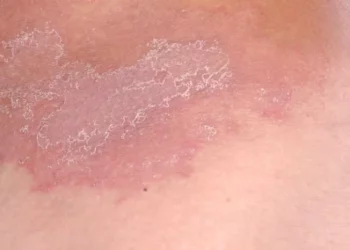Ringworm, despite its name, is neither a worm nor related to worms. This common fungal infection, known scientifically as dermatophytosis, manifests as circular, red, and often itchy patches on the skin. Understanding why ringworm adopts a round shape involves delving into the biology of fungi, the structure of human skin, and the interactions between the pathogen and its host. This article explores these aspects to provide a comprehensive explanation for the characteristic round shape of ringworm.
Introduction to Ringworm
Ringworm is a highly contagious fungal infection that affects the skin, hair, and nails. It is caused by dermatophytes, a group of fungi that thrive on keratin, the protein found in the outer layer of skin, hair, and nails. Common species causing ringworm include Trichophyton, Microsporum, and Epidermophyton. These fungi can infect both humans and animals, making transmission between pets and humans relatively common.
The infection begins as a small, often red or pink, scaly patch and expands outward in a ring-like fashion, giving it the characteristic circular appearance. The center of the lesion may become clear as the fungi move outward, leading to a ring shape that often appears to have a more pronounced, raised, or scaly border.
SEE ALSO: How Do I Know If My Ringworm Is Going Away?
The Biology of Dermatophytes
To understand why ringworm is round, it is essential to explore the biological characteristics of dermatophytes. These fungi are adapted to live on keratinized tissues and possess enzymes, particularly keratinases, which break down keratin. This capability allows them to colonize the skin, hair, and nails.
Dermatophytes grow hyphae, which are long, branching filamentous structures. These hyphae extend through the keratinized tissues, spreading the infection. The growth pattern of hyphae is influenced by several factors, including nutrient availability, host immune responses, and environmental conditions.
The Role of the Host’s Skin
Human skin plays a significant role in the development of the ringworm’s round shape. The skin is the body’s largest organ, consisting of multiple layers that serve as a barrier against pathogens. The outermost layer, the epidermis, is composed primarily of keratinized cells. This layer provides a nutrient-rich environment for dermatophytes.
When dermatophytes infect the skin, they initially colonize a small area. The fungi secrete enzymes to digest keratin, providing them with the nutrients needed for growth. As they deplete the nutrients in the initial site, the fungi need to move outward to find more keratin to sustain their growth. This radial expansion creates the circular shape of the infection.
Mechanisms of Fungal Spread
The spread of dermatophytes is a key factor in the round appearance of ringworm. The fungi grow outward from the initial point of infection in a centrifugal manner. This radial spread is driven by the hyphal growth pattern, which extends outward in search of new keratinized tissue.
As the hyphae grow, they produce spores, or conidia, which can disseminate the infection. These spores are often shed from the surface of the skin and can infect new sites, contributing to the spread of the infection both locally and to new hosts.
Immune Response and Infection Pattern
The host’s immune response also influences the shape of the infection. When the body detects a fungal infection, it mounts an immune response to contain and eradicate the pathogen. This response can include inflammation, which brings immune cells to the site of infection to combat the fungi.
The immune system’s efforts to contain the infection can inadvertently contribute to the ring shape. As immune cells attack the fungi in the center of the lesion, they can sometimes succeed in reducing the fungal load in this area. Meanwhile, the fungi continue to spread outward, where the immune response may be less concentrated. This results in a clearer center with an active, expanding border.
SEE ALSO: Can I Put Bleach on My Skin to Kill Ringworm?
Environmental and Behavioral Factors
Several external factors can influence the appearance and spread of ringworm. These include humidity, temperature, and personal hygiene practices. Dermatophytes thrive in warm, moist environments, which are common in areas where people sweat or in climates with high humidity. This environmental preference can affect the rate of fungal growth and the spread of infection.
Personal hygiene practices, such as frequent washing and drying of the skin, can help prevent the spread of dermatophytes. However, in cases where hygiene is compromised, or skin is frequently moist and warm, the fungi can spread more easily, potentially leading to larger and more pronounced circular lesions.
Comparative Analysis with Other Fungal Infections
Comparing ringworm with other fungal infections provides further insight into its characteristic round shape. For instance, Candida infections, caused by yeast-like fungi, typically do not form round lesions. Candida thrives in mucosal areas, such as the mouth and genital regions, where it causes infections like thrush and vaginal yeast infections. These infections often present as diffuse, rather than circular, lesions due to the different growth patterns and environmental preferences of Candida species.
In contrast, dermatophytes have evolved to efficiently colonize keratinized tissues, necessitating a radial growth pattern to maximize nutrient acquisition. This adaptation results in the distinctive ring-shaped lesions of ringworm.
Historical and Cultural Perspectives
The history and cultural understanding of ringworm add another layer to our comprehension of this infection. Historically, ringworm has been recognized for centuries, with descriptions dating back to ancient civilizations. The characteristic ring shape likely contributed to the belief that the infection was caused by a worm, hence the name “ringworm.”
Cultural practices and beliefs have influenced the treatment and management of ringworm throughout history. In some cultures, traditional remedies and natural treatments have been used to combat the infection. Understanding the historical context of ringworm helps to appreciate the evolution of medical knowledge and the ongoing efforts to effectively manage and treat this common infection.
Modern Medical Approaches
Modern medicine has made significant strides in diagnosing and treating ringworm. Dermatologists can often diagnose the infection based on its appearance and may confirm it with microscopic examination or culture of skin scrapings. Treatment typically involves antifungal medications, which can be applied topically or taken orally, depending on the severity and location of the infection.
The development of antifungal drugs has been crucial in managing ringworm. These medications target the fungal cells, disrupting their ability to grow and reproduce. Understanding the biology of dermatophytes has been essential in developing effective treatments and in improving outcomes for those affected by ringworm.
Preventive Measures
Preventing ringworm involves a combination of personal hygiene practices and environmental management. Regular washing and drying of the skin, avoiding sharing personal items such as towels and clothing, and maintaining a clean living environment can help reduce the risk of infection.
In environments where ringworm is more prevalent, such as schools, gyms, and animal shelters, additional measures may be necessary. These can include regular cleaning and disinfection of shared spaces and educating individuals about the signs and symptoms of ringworm and the importance of early treatment.
Conclusion
The round shape of ringworm is the result of a complex interplay between the biological characteristics of dermatophytes, the structure of human skin, and the host’s immune response. The radial growth pattern of the fungi, driven by their need to find new sources of keratin, leads to the characteristic ring-shaped lesions. Understanding this process provides valuable insights into the nature of fungal infections and highlights the importance of effective prevention and treatment strategies.
Ringworm remains a common and often bothersome infection, but advances in medical science and hygiene practices have significantly improved our ability to manage and treat it. By continuing to explore the biology of dermatophytes and the dynamics of fungal infections, we can further enhance our understanding and control of this widespread condition.
Related Topics:

























